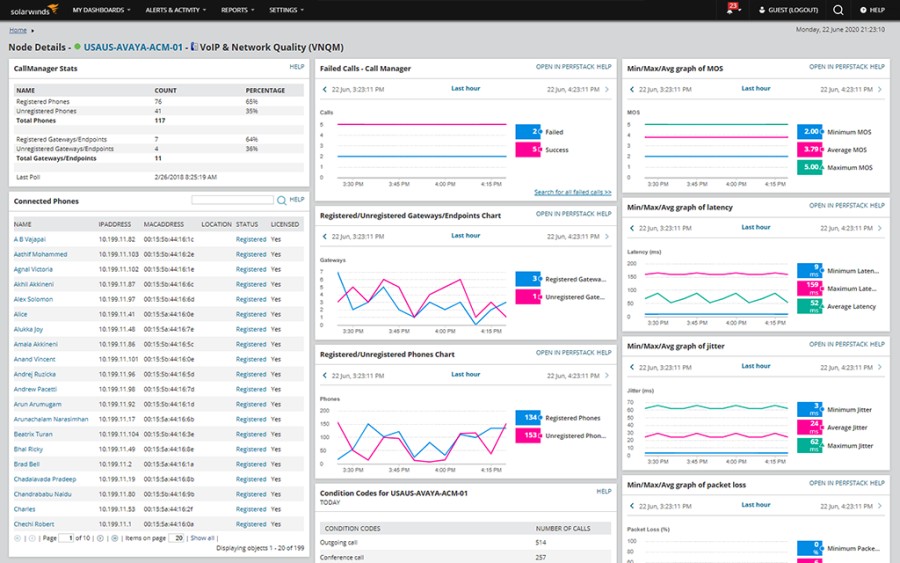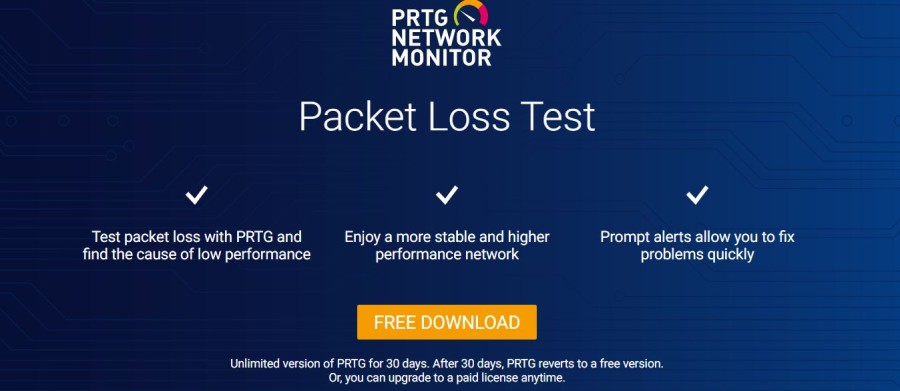A stable network connection is vital for every business.
No wonder why people invest in quality internet connection and Wi-Fi while ensuring everything runs smoothly to execute their organizational operations.
Despite all these, you may experience huge volumes of packet loss that can impact your connectivity, application availability, and performance. As a result, you may observe frequent lags and reduced operational efficiency.
Therefore, knowing how to prevent or stop different types of packet loss involving your internet connection, ping, or Wi-Fi is crucial.
A packet loss testing and monitoring solution is designed to serve this very purpose.
In this article, I’ll introduce you to the concept of data packets, packet loss, its impacts, and how you can monitor and fix it to maintain a stable network.
Let’s begin.
What are Packets?
Data packets are smaller units of data traveling along a network path. In fact, every activity on the internet is made of packets, from browsing the web, downloading files, and sending emails to whatnot.
These units might not make sense individually because they are portions of a message transmitting from a source to a destination packaged into several layers. But when these packets of the overall message are combined, they mean something.
Packets move through different hubs during their journeys, such as fiber optics, copper cables, and wireless routers. When the packets reach their destination successfully, they are time stamped.
What is Packet Loss?

Packet loss happens when one or a group of packets traveling along a network connection don’t reach their final destination. This means packets are ‘lost,’ delayed, or misplaced somewhere in the hubs while traveling through them.
When a packet is delayed, it will time out eventually, and another one will replace it. And when no packet is sent to make the replacement, the recipient would receive some parts of the requested data or message incoherently, incomplete, flawed, or damaged. Over time, all the packets will arrive, but it is late arrival with poor network performance.
The causes of packet loss are errors or issues in data transmission across a given wireless network or due to network congestion. The issues can be faulty cables, insufficient bandwidth or hardware, software bugs, security threats, overloaded devices, etc.
How can it impact your business?
Packet loss results in plenty of network problems, specifically in wireless networks and wide area networks (WANs).
In general, it will reduce the throughput and speed of a given network connection.
Sometimes, packet loss can lower the quality of latency-sensitive protocols or apps such as voice-over IPs, streaming videos, video conferencing, etc. It may also increase your CPU load for processing the added network overhead.
In addition, you may experience reduced speed while downloading files and more latencies and delays for real-time apps. All of them will ultimately result in reduced organizational efficiency that can disrupt your business.
However, with packet loss testing, you can detect issues accountable for packet loss and fix them before they could harm your business by weakening your network performance, application availability, etc.
So, let’s look at some of the best packet loss monitoring and testing solutions to save your business from these issues.
Packet Loss Test
Packet Loss Test uses the advanced WebRTC technology that helps you check the latency, latency jitter, and packet loss of your internet connection for FREE in your browser.
These issues are caused due to various reasons that you can detect and fix with this easiest solution. It includes a traditional speed test that measures your network’s latency and speed. Speed is essential for general web browsing, video streaming, and downloading files, but it’s not very evident for performance when it involves more communicative tasks.

Tasks like voice chat and gaming don’t need greater bandwidth, but they require reliable and prompt responses. Also, some programs fail to resend information, and packets are lost during the process. For these purposes, they use WebRTC that plays a vital role in modern browsers.
With WebRTC, you can quickly test the packet loss without installing a complicated tool. Instead, it is effortless to use, and you simply need to set packet sizes, frequency, duration, acceptable delay, server, and approximation to start the test and see the result.
SolarWinds
Improve the performance of your network by testing packet loss with SolarWinds. Understand the cause of loss and fix the issue quickly with this easy-to-use solution. It designs VoIP and Network Quality Manager (VNQM) to look into the network conditions necessary for VoIP delivery.
SolarWinds can get call data either from Cisco Unified or Avaya Aura Communications Managers so that you can quickly know the issue of latency, call noise, and jitter. With metric monitoring and call data, you can troubleshoot the packet loss quickly.

This real-time packet monitoring tool helps you detect the cause, check the solutions, and measure the loss of packets to get faster results. Find the root cause by tracking and analyzing the loss over a given time for all the connection problems.
If you wish to get a faster response, SolarWinds gives you the PerfStack feature. This feature helps you relate packet loss with a broader range of data to get the root cause faster. In addition, SolarWinds integrates with VoIP statistics to show you real-time data of quality drops which may cause packet loss.
VNQM designs a dashboard to show you call paths in a graph, just like the speedometer design in a car. Also, the visualization is more precise due to the use of color-code statuses that help you view the health of every path.
EMCO Ping Monitor
EMCO Ping Monitor helps you monitor connection quality and the up/down state of network devices. For this purpose, EMCO Ping Monitor uses ICMP and estimates connection stability based on jitter metrics, latency, and packet loss.
With the packet loss test, you will get the data regarding latency deviation, uptime percentage, average latency, outages list, etc. Ping Monitor helps you find hosts easily with different quality and state characteristics to get detailed information.
The software supports Windows Tray, sound notifications, emails, and custom notifications. In addition, its built-in tools allow you to receive reports and real-time data. It can also monitor 8000 hosts with 0.01ms latency precision through a special performance engine.
Here, the connection quality is assessed as a warning – good, critical, or bad, using monitoring metrics. Customize the criteria of the assessment as per your need to get real-time, accurate results. You can check the metrics that change over time from the charts.
Every ping is stored to let you see all pings on a chart and check how they change. In addition, you can export the ping data to open it for analysis in the external tool. Generate HTML and PDF reports of detailed statistics so that you can save them, upload them to FTP, or send them by email.
Compare editions before choosing and select the one which fits your budget and requirement. You can go for a FREE edition or a paid edition at a starting price of $199.
iPerf3
If you are searching for a tool that can do active measurements to achieve maximum bandwidth on each IP network, go for iPerf3. It helps in tuning different parameters related to buffers, protocols (TCP, SCTP, UDP with IPv6 and IPv4), and timing.
For every test, it shows the packet loss, bandwidth, and other parameters. iPerf3 is developed by Lawrence Berkeley National Laboratory/ESnet and released within a three clause BSD license. It consists of many features that help you track all the data.
SCTP and TCP measure bandwidth, report MTU/MSS size, observe read sizes, and support TCP size of the window through socket buffers. In addition, UDP can calculate packet loss and measure delay in jitter metrics.
Furthermore, the server can handle multiple connections after the test. iPerf has also added some new features like setting target bandwidth for TCP and UDP, setting IPv6 flow label, getting output in JSON format, and many more. Furthermore, you can try this ultimate packet loss testing tool to calculate the speed limits of the network and internet neutrality.
Paessler PRTG
Identify the cause of packet loss with Paessler PRTG. PRTG Ping Sensor is used to measure packet loss on a percentage basis. The Quality of Service (QoS) Round Trip Sensor allows you to monitor the network to measure packet loss and reduce it.
It comes with a Cisco IP SLA Sensor that measures the rate of packet loss on the devices. PRTG monitors the website network traffic and detects load peaks. It also monitors the device performance to uncover bottlenecks. You can deploy the Windows CPU Load and SNMP CPU Load Sensor for CPU monitoring and keep an eye on the hardware to detect sudden changes in the device’s readings.

You can also spot errors in software by creating an Event Log sensor to read messages and software logs. PRTG helps you monitor all the devices, applications, and traffic with a single monitoring tool and allows you to receive alerts in case of any issues occurring. It also helps achieve your goal of attaining 0% packet loss; hence, you’ll get error-free and high-performance packets traveling in the network.
Try PRTG with a 30-day free trial and allow it to keep the focus on the entire network. You can also go for paid plans at a starting price of $1750 and avail the benefit of using more sensors.
OpManager
OpManager offers a simplified packet loss monitoring solution that is super easy to install, run, and use. It is customizable to the various needs of a network monitoring administrator and comes with a rich collection of features to help you manage packet loss efficiently.
The real-time pocket monitoring solution – OpManager – offers a mobile application for Android, iPad, and iPhone so you can monitor packets all the time and perform troubleshooting.
You can also receive alarms and notifications and stay updated with network availability, packet information, network performance, list of devices connected, and the health of the entire IT infrastructure, no matter where you are. In addition, the software enables you to customize the dashboard to get a quick view of all the metrics on a single screen.
Another appreciable thing about OpManager is that it has a highly scalable monitoring architecture, and you have multiple add-ons to choose from to extend its scope. OpManager has a transparent and affordable licensing model as well.
Bonus Tips to fix Packet Loss
Apart from using a packet loss monitoring or testing solution, make sure you follow some practices to prevent or fix data loss:
- Check if all the ports and cables are installed and connected properly
- Use cable connections instead of wireless to improve your network connection quality
- If you use Wi-Fi, use a wired connection
- If you experience any bugs or faults, you can try restarting the hardware and routers in your network.
- Upgrade network infrastructure by replacing deficient or obsolete hardware systems
- Ensure all your devices are updated to reduce bugs and maintain security
- Prioritize your application usage to ensure you use the most important ones while maintaining the network bandwidth and avoiding overloads
- Remove sources causing interference in your network, such as cameras, wireless phones, speakers, power lines, etc.
Conclusion
In this digital age, network stability is crucial to ensure the smooth running of your business operations. Never let packet loss disturb your workflow by detecting the issues responsible for it and fix them on time using packet loss monitoring and testing solutions we just discussed.



